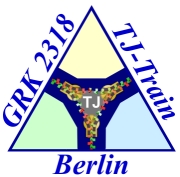
DFG Research Training Group "TJ-Train" (GRK 2318/1)
Tight junctions and their proteins
Molecular features and actions in health and disease
Project A1, 1st cohort:
Background: Electrophysiological methods have a
long tradition in epithelial physiology. However, new developments both in the molecular understanding of the tight
junction (TJ) and in the measuring technology make new approaches possible.
Hypotheses:
Combining impedance spectroscopy with specific alterations of partial epithelial
resistances will allow us to quantify the contribution of different epithelial components towards general barrier
function of simple and stratified epithelia. Refinement by combining brief, reversible alteration with fast
multisinus impedance spectroscopy will generate a method for a detailed analysis of the mechanisms underlying the
action of toxins and drugs.
Aims:
This project aims to resolve the relative contributions of trans- and paracellular pathways as well as stratum
corneum components towards barrier function in simple and stratified epithelia, respectively. Healthy and diseased
tissues will be compared and effects of pharmacological treatment on different barrier components will be
evaluated.
Methods:
Standard molecular biological methods will be used for the knockout/knockdown of
specific claudins and for the over-expression of ion channels or TJ components. Resulting cell clones will be
cultivated (standard and 3D cell culture) and used for Ussing-chamber-based impedance spectroscopy. Multisinus
technique for fast impedance spectroscopy has recently been implemented and will be rigorously tested in simple as
well as stratified epithelial cell culture. Data will be evaluated by fitting to various equivalent circuit models
and by using COMSOL Multiphysics® Modeling Software. Morphological conclusions from impedance measurements will be
cross-validated with optical methods (confocal laserscanning microscopy; transmission electron microscopy).
Thesis project:
As part of this PhD project we will adapt equivalent electric circuits by
employing established cell culture models for simple and stratified epithelia. Expression of TJ proteins will be
perturbed (e.g. by specific knock-down of TJ proteins or by application of cytokines). The transcellular pathway
will be affected by application of ionophores, pore-forming bacterial toxins or by overexpression/activation of
ion channels). Trans- and paracellular barrier components will be quantified by modelling impedance spectroscopic
data, and visualized by various optical techniques.
Suggested reading: See
Project-related publications, especially Refs. 2,
3, and 8
1st cohort PhD doctoral student
-
Roman Mannweiler

19.08.2021: Doctoral examination passed, "Untersuchung der epithelialen Barriere mittels Impedanz-Spektroskopie und Leitfähigkeitsmikroskopie",
Dr. ing., Technische Universität Berlin,
magna cum laude
Mannweiler R, Bergmann S, Vidal-Y-Sy
S, Brandner JM, Günzel D (2021) Direct assessment of individual skin barrier components by electrical impedance
spectroscopy. Allergy
76(10): 3094-3106 (13 pages). doi: 10.1111/all.14851,
Supplement PDF (IF 14.7)
Beier LS*, Waldow A* (*shared first authorship), Khomeijani Farahani S, Mannweiler R, Vidal-Y-Sy S, Brandner JM, Piontek J°, Günzel D° (°shared last
authorship) (2022) Claudin targeting as an effective tool for directed barrier modulation of the viable epidermis. Ann. NY Acad. Sci.
1517(1): 251-265, doi: 10.1111/nyas.14879 (°IF 6.5)
1st cohort MD doctoral student, 1st cohort
-
Ahmad Mouna
 
Alzahrani AS, Hussein M, Alswailem M, Mouna A, Albalawi L, Moria Y, Jabbar MA,
Shi Y, Günzel D*, Dasouki M* (*equally contributing) (2021) A novel claudin-10 mutation with a unique
mechanism in two unrelated families with HELIX syndrome. Kidney Int.
100(2): 415-429, doi: 10.1016/j.kint.2021.02.023,
Supplement
(IF 19.0)
Project-related publications
-
Milatz S*, Himmerkus N* (*shared first authorship),
Wulfmeyer VC, Drewell H, Mutig K, Hou J, Breiderhoff T, Müller D, Fromm M, Bleich M°, Günzel D°
(°shared last authorship) (2017) Mosaic expression of claudins in thick ascending limbs of Henle results in spatial
separation of paracellular Na+ and Mg2+
transport. Proc. Natl. Acad. Sci. USA
114(2): E219-E227
[PubMed] [WebPage]
[PDF+Supplement] .
"Paper of the month" 03/2017 of the German Physiological Society
-
Schmid T, Bogdan M,
Günzel D
(2013) Discerning apical and basolateral properties of HT-29/B6 and IPEC-J2 cell layers by impedance spectroscopy,
mathematical modeling and machine learning.
PLOS One 8(7): e62913 (printed pages 1-12) [PubMed]
[WebPage] [PDF]
[Supplements, PDF]
-
Günzel D,
Zakrzewski S, Schmid T, Pangalos M, Wiedenhoeft J, Blasse C, Ozboda C, Krug SM (2012) From TER to trans- and
paracellular resistance: Lessons from impedance spectroscopy. Ann. N.Y. Acad. Sci.
1257: 142-151 [PubMed] [WebPage]
[PDF]
-
Krug SM, Günzel D, Conrad MP, Rosenthal R, Fromm
A, Amasheh S, Schulzke JD, Fromm M (2012) Claudin-17 forms tight junction channels with distinct anion selectivity.
Cell. Mol. Life Sci. 69(16): 2765-2778 [PubMed]
[WebPage] [PDF]
[Supplement]
-
Milatz S, Krug SM, Rosenthal R,
Günzel D, Müller D, Schulzke JD, Amasheh S*, Fromm M* (*shared last authorship) (2010) Claudin-3 acts as a
sealing component of the tight junction for ions of either charge and uncharged solutes.
Biochim. Biophys. Acta Biomembr. 1798: 2048-2057 [PubMed]
[WebPage] [PDF]]
-
Krug SM, Amasheh S, Richter JF, Milatz S, Günzel D,
Westphal JK, Huber O, Schulzke JD, Fromm M (2009) Tricellulin forms a barrier to macromolecules in tricellular tight
junctions without affecting ion permeability. Mol. Biol. Cell 20:
3713-3724 [PubMed] [WebPage]
[PDF] [Supplement
text] [Supplement
video]
-
Günzel D, Stuiver M, Kausalya PJ, Haisch L,
Krug SM, Rosenthal R, Meij IC, Hunziker W, Fromm M, Müller D (2009a) Claudin-10 exists in six alternatively spliced
isoforms which exhibit distinct localization and function. J. Cell Sci.
122: 1507-1517 [PubMed] [WebPage]
[PDF]
-
Krug SM, Fromm M, Günzel D
(2009) Two-path impedance spectroscopy for measuring paracellular and transcellular epithelial resistance.
Biophys. J.
97(8): 2202-2211 [PubMed] [WebPage]
[PDF] [Supplement]
-
Zeissig S, Bürgel N, Günzel D, Richter JF,
Mankertz J, Wahnschaffe U, Kroesen AJ, Zeitz M, Fromm M, Schulzke JD (2007) Changes in expression and distribution
of claudin-2, -5 and -8 lead to discontinuous tight junctions and barrier dysfunction in active Crohn's disease.
Gut 56(1): 61-72 [PubMed]
[WebPage] [PDF]
-
Reiter B, Kraft R, Günzel D, Zeissig S, Schulzke
JD, Fromm M, Harteneck C (2006) TRPV4-mediated regulation of epithelial permeability.
FASEB J.
20: 1802-1812 [PubMed]
[WebPage] [PDF]
-
Tunggal JA*, Helfrich I* (*shared first authorship),
Schmitz A, Schwarz H, Günzel D, Fromm M, Kemler R, Krieg T, Niessen CM (2005) E-cadherin is essential for in
vivo epidermal barrier function by regulating tight junctions. EMBO J.
24: 1146-1156 [PubMed]
[WebPage] [PDF]
|
